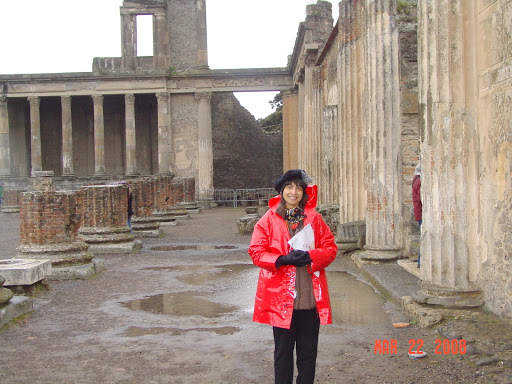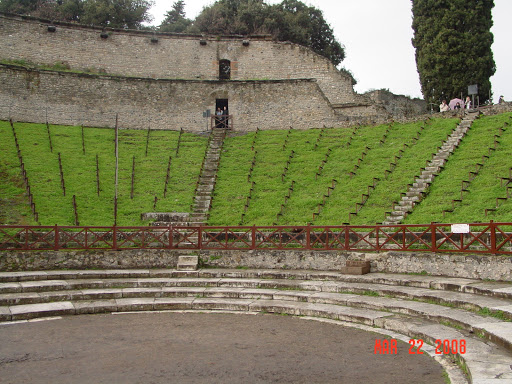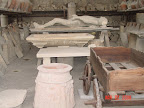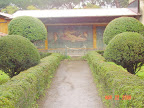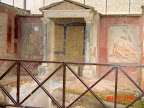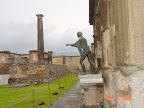Pompei’s Pomp and Splendor
(Amidst the ruins of the excavated city of Pompei)
A storm had accosted the Southern coast of Italy by the time we awoke, the next morning. Making a quick decision to reverse plans and go to Pompei instead of Capri as planned, we breakfasted well at Bonapace Bed and Breakfast and strolled downstairs towards the Circumvesuviana station where a day-long excursion ticket costing 5.50 Euros allowed unlimited travel all day as far away as the end of the line in Sorrento.
The train rode through the city of Naples for a long while exposing us to small apartments with cluttered balconies. Within a few minutes, outside our window, grey and overcast skies with ominous clouds hanging low obscured the summit of Mount Vesuvius (left) whose notorious volcano was active as recently as 1964 when the town of Torro el Greco, close to Pompeii was affected. It was to see the havoc wrought by its ash and lava that we were headed for Pompeii, passing, along the way, the town of Ercolano, base for explorations into Heculaneum as it was once known, another town that was destroyed by the volcano. Ercolano is also the base from which one might take a bus to the summit of Vesuvius which the energetic can then scale. However, with the weather being so uncooperative, all buses to the summit had been cancelled.
In another 45 minutes, we were alighting from the train in Pompeii and walking a couple of minutes to Porta Marina, the main entrance to the excavated city. Despite the rain, the venue was swarming with visitors, all assembled at the main Ticket kiosk to purchase tickets to the complex. The 10 Euro ticket did not include the audio guide (10 Euros for 2 or 6 Euros for one) but since our guidebooks recommended that we invest in it to bring some organization to our rambling, we did–and how grateful we were!
History of Pompeii’s Destruction:
The map of Pompeii that came with the audio guide was very helpful indeed. It is difficult to imagine exactly how vast this complex is—in fact, one is visiting an actual city that thrived in the time of the Romans, not just some museum reproduction. It was in AD 79 that Vesuvius exploded with little warning pouring its deadly lava over the unprepared city and burying it forever under endless layers of ashen rock. The roofs of the town caved under the weight of the onslaught; but beneath them the city was preserved almost intact as it had been on that fateful day. Most of our accounts of the catastrophe come from the pen of historian Pliny the Elder who found himself on a barge in the Bay of Naples from where he watched the city burn. Returning later to Pompeii when he linked forces with his nephew Pliny the Younger, he perished himself in the aftershocks that continued to plague the area for a long while. His nephew then took up the challenge of recording the devastation. The buried city remained unknown until the 17th century. Excavations began in 1748 revealing a city frozen in time.
Exploring Pompei’s Buried Glory:
As Amy and I walked through Porta Marina (so-called because it was the entrance at the city gates nearest the sea), a fine drizzle played continually making it difficult to manipulate umbrella, guidebook, map and camera in two gloved hands–because it was also very cold. Doing the best we could, we spent the morning visiting the Temple of Apollo, The Law Courts (it pays to remember that Western legal systems of jurisprudence derive entirely from the ancient Roman codes), The Macellum or Market Place, and the Botanical Gardens full of the herbs and fruit that were used for medicinal, cosmetic and culinary purposes in that era. Herbs like rosemary and lavender lent their fragrance and essences to cooking as well as to scented baths for luxurious soaking.
Following the map, we arrived at the ‘School’ or campus where students were taught the 3 Rs—the complex is designed around a quadrangle exactly like those of Western medieval colleges (Oxford and Cambridge, for instance) with columned alleys forming the kind of corridors that one associates with Gothic cloisters.
And then we arrived at the amphitheaters (left)—the large one and a smaller one near-by—where the Romans gathered periodically for theatrical entertainment. I could not help but think about the comedies of Plautus and Terence of which I had heard during my undergraduate years and, aptly enough, the audio guides provided some snippets from their plays.
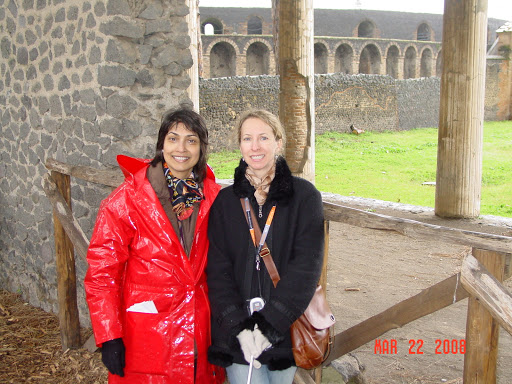 As if to dispel any misconceptions that the Roman temperament was only composed of noble qualities, at the very end of the complex was the colloseum (left) where the bloodiest of sporting events were held—gladiators in live combat with wild beats. I found it hard to understand how a people of such sophistication, such lovers of art and literature and learning, could also express such an unabashed enjoyment of violent sport. In the massive arena which seats thousands, once could well see and almost hear the blood-curdling cries that emerged from the crazed masses. It occurred to me to feel grateful for the modern customs and traditions that we owe to this Classical civilization; yet, how happy I felt that it had become extinct. I was eager to leave that scene of sadism behind to wander towards the cafeteria for a much-needed lunch as our ramblings, though taken at leisurely pace, were exhausting as the environs are vastly spread out. The food here was very mediocre and cost a Roman senator’s ransom—so be warned and come equipped with a packed lunch. However, the complex offered some respite from the incessant rain and the opportunity to use the restrooms.
As if to dispel any misconceptions that the Roman temperament was only composed of noble qualities, at the very end of the complex was the colloseum (left) where the bloodiest of sporting events were held—gladiators in live combat with wild beats. I found it hard to understand how a people of such sophistication, such lovers of art and literature and learning, could also express such an unabashed enjoyment of violent sport. In the massive arena which seats thousands, once could well see and almost hear the blood-curdling cries that emerged from the crazed masses. It occurred to me to feel grateful for the modern customs and traditions that we owe to this Classical civilization; yet, how happy I felt that it had become extinct. I was eager to leave that scene of sadism behind to wander towards the cafeteria for a much-needed lunch as our ramblings, though taken at leisurely pace, were exhausting as the environs are vastly spread out. The food here was very mediocre and cost a Roman senator’s ransom—so be warned and come equipped with a packed lunch. However, the complex offered some respite from the incessant rain and the opportunity to use the restrooms.
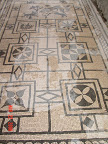 Back on the excavated trail, we arrived at the Public Baths, beautifully refurbished in recent years. As we walked from one bathing chamber to the next, we understood the concept of public bathing. At a time when running water was not available in homes, public baths served the purpose of keeping citizens clean as well offered an opportunity to socialize. Men and women gathered together to shoot the breeze, their baths providing a choice of hot, cold and sauna soaks. The extent of the ornamentation inside in the form of fresco and sculpture was quite amazing.
Back on the excavated trail, we arrived at the Public Baths, beautifully refurbished in recent years. As we walked from one bathing chamber to the next, we understood the concept of public bathing. At a time when running water was not available in homes, public baths served the purpose of keeping citizens clean as well offered an opportunity to socialize. Men and women gathered together to shoot the breeze, their baths providing a choice of hot, cold and sauna soaks. The extent of the ornamentation inside in the form of fresco and sculpture was quite amazing.
 Also, along the same trail was the Bakery (left) where one can still see the massive grinding stones in which wheat was ground, the great dough kneading machines and the very ovens in which the loaves were fashioned. Amazing how baking techniques have changed little in thousands of years—the same steps that bakers take today to bring fresh loves to our table were taken in the time of Ancient Rome.
Also, along the same trail was the Bakery (left) where one can still see the massive grinding stones in which wheat was ground, the great dough kneading machines and the very ovens in which the loaves were fashioned. Amazing how baking techniques have changed little in thousands of years—the same steps that bakers take today to bring fresh loves to our table were taken in the time of Ancient Rome.
Then we were at the Brothel where the oldest profession in the world was carried out. Interestingly, the frescoes in this building reveal clear images of a variety of sexual positions indicating that clients could choose the exact form in which they wished to take their pleasures.
What was also fascinating was the large enclosure within which the thousands of items excavated from Pompeii have been stored—these included hundreds of terracotta amphorae, jars, fountains and bird baths, pots and pans, bowls and, in an extremely eerie turn, real casts of the people who perished in the tragedy—concrete casts that portray their exact ‘petrified’ poses and expressions at the time they met their end (left)
It was the homes called Casas and Dormus in Latin with their indoor atriums and outdoor gardens, however, that I found most fascinating. So many of them have frescoes on their walls that are still intact, almost as fresh as the day they were executed. There was Diana and there was Venus on the half-shell (above left and right), Pan and Cupid and a variety of nymphs; and at the House of Vetii was Priapus, God of the Penis! We realized how ‘religious’ the Romans were for images of their gods and goddesses were sprinkled all over their homes. I loved the layout of their houses.
All rooms opened upon a walled courtyard (left)which would have been full of yews, boxwood borders and pebbled pathways, not to mention a central fountain with decorative statues. Modern-day formal Italianate gardens are little different from this early design.
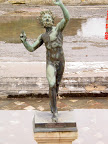 Walls inside and out were painted with a bright red pigment, much of which still remains to give the visitor an idea of exactly how the city might have looked. Some of the houses are in better shape than others—for example, the frequently-visited House of the Faun, so-called because a faun or satyr (a mythological woodland human) graces its entrance (left) .
Walls inside and out were painted with a bright red pigment, much of which still remains to give the visitor an idea of exactly how the city might have looked. Some of the houses are in better shape than others—for example, the frequently-visited House of the Faun, so-called because a faun or satyr (a mythological woodland human) graces its entrance (left) .
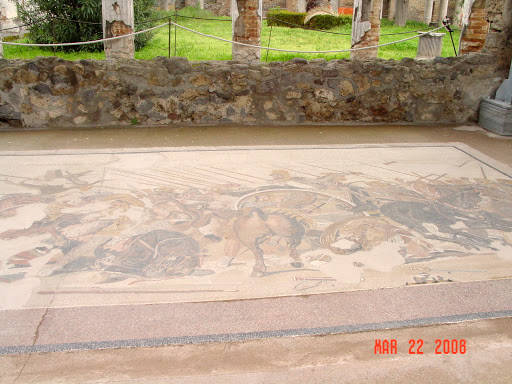 In the same house was found the striking floor mosaic featuring Alexander the Great and King Darius of Persia in combat–(left) (the original of which we had seen the previous evening at the Archeological Museum in Naples). The sophistication and the lifestyle of these ancient people was so fascinating to me that I found myself transported completely into that epoch as I trod along the gigantic rough hewn boulders that comprised the main avenue that runs through the city of Pompeii, Via dell’ Abbondanza upon which chariots and carts once plied. The town planning and road building skills of the ancient Romans cannot be faulted and the neat grid right-angled pattern according to which modern urban complexes have been designed does them enormous credit.
In the same house was found the striking floor mosaic featuring Alexander the Great and King Darius of Persia in combat–(left) (the original of which we had seen the previous evening at the Archeological Museum in Naples). The sophistication and the lifestyle of these ancient people was so fascinating to me that I found myself transported completely into that epoch as I trod along the gigantic rough hewn boulders that comprised the main avenue that runs through the city of Pompeii, Via dell’ Abbondanza upon which chariots and carts once plied. The town planning and road building skills of the ancient Romans cannot be faulted and the neat grid right-angled pattern according to which modern urban complexes have been designed does them enormous credit.
It took a lot of imagination to envision the many excavated artifacts and statuary that crams the Archeological Museum in Naples in situ. I couldn’t help wishing that the Italian authorities would place more replicas of these great pieces of sculpture and mosaic in Pompeii to give visitors an idea of how these priceless works of arts might have looked when they actually decorated the city. Still, I guess one has to protect such things from the merciless elements and more merciless thieves. In the Temple of Apollo, for instance, it made such a big difference to actually see the statue of Apollo in a building as it might have been when the Temple was a favorite Roman meeting place in the days of antiquity (above left).
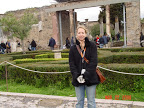 I must stress that all this exploration was deeply tiring. I have been told that during the height of the summer tourist season there are mobiles that take visitors around the complex. Those weren’t running when we were visiting in mid-March. It was also very cold and the awful weather did not make for very pleasant sightseeing. A great number of the gates to the various buildings were padlocked, prohibiting our entry. However, the interest contained within this complex is so great that one disregards these inconveniences and succumbs to the sheer fascination of time-traveling to another era when the Roman Empire was the most powerful in the world.
I must stress that all this exploration was deeply tiring. I have been told that during the height of the summer tourist season there are mobiles that take visitors around the complex. Those weren’t running when we were visiting in mid-March. It was also very cold and the awful weather did not make for very pleasant sightseeing. A great number of the gates to the various buildings were padlocked, prohibiting our entry. However, the interest contained within this complex is so great that one disregards these inconveniences and succumbs to the sheer fascination of time-traveling to another era when the Roman Empire was the most powerful in the world.
Back in Naples:
Back on the train to Naples, we arrived in the city in time to snatch a brief nap at our hotel, then go out in search of dinner. Amy used Lonely Planet to find us a suitable trattoria that took us walking for what seemed like miles through the maze of small lanes that open up suddenly into church piazzas in the city’s busy historic center. It being Holy Saturday, the eve of Easter Sunday, confectionery shops were full of pastries, cakes and Easter eggs and housewives hurried along the streets doing last-minute shopping for their big holiday meal. These ventures into the least-explored parts of Naples allowed us to see the city in its most natural guise. We penetrated parts of the city in which ordinary Napolitans live their uncomplicated lives, arriving finally at the small Trattoria del Carmine on Via del Tribunali in the old historic quarter close to the Duomo where we were startled to find one of the priests from the Duomo of St. Gennaro opposite come inside for dinner! Obviously a regular, he was ushered inside—to a privileged table, perhaps?
We, however, settled for a carafe of the house Chianti which was excellent and used it to wash down our meal of Penne alla Carmine (the house pasta that came with a delicious Tomato and Meat sauce), a Veal Scallopini in Lemon Sauce (since Naples grows lemons in wild profusion) and Sauteed Brocollini also flavored with lemons. Indeed Naples is noted for its lush production of lemons and we passed hundreds of acres of lemon orchards on our train journeys along the Bay of Naples. Hence, it was only natural that I would try a Limoncello, the famous lemon liqueur that was invented in this region and has become one of Italy’s biggest exports. Needless to say, I relished every drop, and (much to Amy’s amusement) feeling slightly tipsy we made our way back to our hotel to call it a day hoping that the weather on the morrow would be better.
To follow Amy and me on the next left of our travels to the Isle of Capri in Italy, please click on the link below.
Bon Voyage
